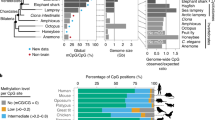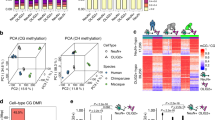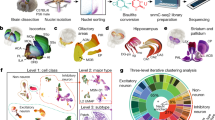Abstract
DNA methylation has critical roles in the nervous system and has been traditionally considered to be restricted to CpG dinucleotides in metazoan genomes. Here we show that the single base–resolution DNA methylome from adult mouse dentate neurons consists of both CpG (∼75%) and CpH (∼25%) methylation (H = A/C/T). Neuronal CpH methylation is conserved in human brains, enriched in regions of low CpG density, depleted at protein-DNA interaction sites and anticorrelated with gene expression. Functionally, both methylated CpGs (mCpGs) and mCpHs can repress transcription in vitro and are recognized by methyl-CpG binding protein 2 (MeCP2) in neurons in vivo. Unlike most CpG methylation, CpH methylation is established de novo during neuronal maturation and requires DNA methyltransferase 3A (DNMT3A) for active maintenance in postmitotic neurons. These characteristics of CpH methylation suggest that a substantially expanded proportion of the neuronal genome is under cytosine methylation regulation and provide a new foundation for understanding the role of this key epigenetic modification in the nervous system.
This is a preview of subscription content, access via your institution
Access options
Subscribe to this journal
Receive 12 print issues and online access
$209.00 per year
only $17.42 per issue
Buy this article
- Purchase on Springer Link
- Instant access to full article PDF
Prices may be subject to local taxes which are calculated during checkout








Similar content being viewed by others
Accession codes
References
Borrelli, E., Nestler, E.J., Allis, C.D. & Sassone-Corsi, P. Decoding the epigenetic language of neuronal plasticity. Neuron 60, 961–974 (2008).
Feng, J. & Fan, G. The role of DNA methylation in the central nervous system and neuropsychiatric disorders. Int. Rev. Neurobiol. 89, 67–84 (2009).
Day, J.J. & Sweatt, J.D. DNA methylation and memory formation. Nat. Neurosci. 13, 1319–1323 (2010).
Zhang, T.Y. & Meaney, M.J. Epigenetics and the environmental regulation of the genome and its function. Annu. Rev. Psychol. 61, 439–466, C1–C3 (2010).
Ma, D.K. et al. Epigenetic choreographers of neurogenesis in the adult mammalian brain. Nat. Neurosci. 13, 1338–1344 (2010).
Nelson, E.D. & Monteggia, L.M. Epigenetics in the mature mammalian brain: effects on behavior and synaptic transmission. Neurobiol. Learn. Mem. 96, 53–60 (2011).
Gräff, J., Kim, D., Dobbin, M.M. & Tsai, L.H. Epigenetic regulation of gene expression in physiological and pathological brain processes. Physiol. Rev. 91, 603–649 (2011).
Telese, F., Gamliel, A., Skowronska-Krawczyk, D., Garcia-Bassets, I. & Rosenfeld, M.G. “Seq-ing” insights into the epigenetics of neuronal gene regulation. Neuron 77, 606–623 (2013).
Bird, A. DNA methylation patterns and epigenetic memory. Genes Dev. 16, 6–21 (2002).
Law, J.A. & Jacobsen, S.E. Establishing, maintaining and modifying DNA methylation patterns in plants and animals. Nat. Rev. Genet. 11, 204–220 (2010).
Wu, S.C. & Zhang, Y. Active DNA demethylation: many roads lead to Rome. Nat. Rev. Mol. Cell Biol. 11, 607–620 (2010).
Klose, R.J. & Bird, A.P. Genomic DNA methylation: the mark and its mediators. Trends Biochem. Sci. 31, 89–97 (2006).
Chahrour, M. & Zoghbi, H.Y. The story of Rett syndrome: from clinic to neurobiology. Neuron 56, 422–437 (2007).
Guy, J., Cheval, H., Selfridge, J. & Bird, A. The role of MeCP2 in the brain. Annu. Rev. Cell Dev. Biol. 27, 631–652 (2011).
Holliday, R. & Pugh, J.E. DNA modification mechanisms and gene activity during development. Science 187, 226–232 (1975).
Jones, P.A. & Liang, G. Rethinking how DNA methylation patterns are maintained. Nat. Rev. Genet. 10, 805–811 (2009).
Yokochi, T. & Robertson, K.D. Preferential methylation of unmethylated DNA by mammalian de novo DNA methyltransferase Dnmt3a. J. Biol. Chem. 277, 11735–11745 (2002).
Yoder, J.A., Soman, N.S., Verdine, G.L. & Bestor, T.H. DNA (cytosine-5)-methyltransferases in mouse cells and tissues. Studies with a mechanism-based probe. J. Mol. Biol. 270, 385–395 (1997).
Ramsahoye, B.H. et al. Non-CpG methylation is prevalent in embryonic stem cells and may be mediated by DNA methyltransferase 3a. Proc. Natl. Acad. Sci. USA 97, 5237–5242 (2000).
Lister, R. et al. Human DNA methylomes at base resolution show widespread epigenomic differences. Nature 462, 315–322 (2009).
Laurent, L. et al. Dynamic changes in the human methylome during differentiation. Genome Res. 20, 320–331 (2010).
Lister, R. et al. Hotspots of aberrant epigenomic reprogramming in human induced pluripotent stem cells. Nature 471, 68–73 (2011).
Ziller, M.J. et al. Genomic distribution and inter-sample variation of non-CpG methylation across human cell types. PLoS Genet. 7, e1002389 (2011).
Stadler, M.B. et al. DNA-binding factors shape the mouse methylome at distal regulatory regions. Nature 480, 490–495 (2011); erratum 484, 550 (2012).
Smith, Z.D. et al. A unique regulatory phase of DNA methylation in the early mammalian embryo. Nature 484, 339–344 (2012).
Tomizawa, S. et al. Dynamic stage-specific changes in imprinted differentially methylated regions during early mammalian development and prevalence of non-CpG methylation in oocytes. Development 138, 811–820 (2011).
Ichiyanagi, T., Ichiyanagi, K., Miyake, M. & Sasaki, H. Accumulation and loss of asymmetric non-CpG methylation during male germ-cell development. Nucleic Acids Res. 41, 738–745 (2013).
Xie, W. et al. Base-resolution analyses of sequence and parent-of-origin dependent DNA methylation in the mouse genome. Cell 148, 816–831 (2012).
Lister, R. et al. Global epigenomic reconfiguration during mammalian brain development. Science 341, 1237905 (2013).
Varley, K.E. et al. Dynamic DNA methylation across diverse human cell lines and tissues. Genome Res. 23, 555–567 (2013).
Ma, D.K. et al. Neuronal activity-induced Gadd45b promotes epigenetic DNA demethylation and adult neurogenesis. Science 323, 1074–1077 (2009).
Guo, J.U., Su, Y., Zhong, C., Ming, G.L. & Song, H. Hydroxylation of 5-methylcytosine by TET1 promotes active DNA demethylation in the adult brain. Cell 145, 423–434 (2011).
Guo, J.U. et al. Neuronal activity modifies the DNA methylation landscape in the adult brain. Nat. Neurosci. 14, 1345–1351 (2011).
Zheng, Y. et al. A unique family of Mrr-like modification-dependent restriction endonucleases. Nucleic Acids Res. 38, 5527–5534 (2010).
Chodavarapu, R.K. et al. Relationship between nucleosome positioning and DNA methylation. Nature 466, 388–392 (2010).
Kim, T.K. et al. Widespread transcription at neuronal activity-regulated enhancers. Nature 465, 182–187 (2010).
Marson, A. et al. Connecting microRNA genes to the core transcriptional regulatory circuitry of embryonic stem cells. Cell 134, 521–533 (2008).
Barreto, G. et al. Gadd45a promotes epigenetic gene activation by repair-mediated DNA demethylation. Nature 445, 671–675 (2007).
Hu, X.V. et al. Identification of RING finger protein 4 (RNF4) as a modulator of DNA demethylation through a functional genomics screen. Proc. Natl. Acad. Sci. USA 107, 15087–15092 (2010).
Skene, P.J. et al. Neuronal MeCP2 is expressed at near histone-octamer levels and globally alters the chromatin state. Mol. Cell 37, 457–468 (2010).
Feng, J. et al. Dnmt1 and Dnmt3a maintain DNA methylation and regulate synaptic function in adult forebrain neurons. Nat. Neurosci. 13, 423–430 (2010).
Jia, D., Jurkowska, R.Z., Zhang, X., Jeltsch, A. & Cheng, X. Structure of Dnmt3a bound to Dnmt3L suggests a model for de novo DNA methylation. Nature 449, 248–251 (2007).
Yu, M. et al. Base-resolution analysis of 5-hydroxymethylcytosine in the mammalian genome. Cell 149, 1368–1380 (2012).
Booth, M.J. et al. Quantitative sequencing of 5-methylcytosine and 5-hydroxymethylcytosine at single-base resolution. Science 336, 934–937 (2012).
Mellén, M., Ayata, P., Dewell, S., Kriaucionis, S. & Heintz, N. MeCP2 binds to 5hmC enriched within active genes and accessible chromatin in the nervous system. Cell 151, 1417–1430 (2012).
Suetake, I., Miyazaki, J., Murakami, C., Takeshima, H. & Tajima, S. Distinct enzymatic properties of recombinant mouse DNA methyltransferases Dnmt3a and Dnmt3b. J. Biochem. 133, 737–744 (2003).
Gowher, H. & Jeltsch, A. Enzymatic properties of recombinant Dnmt3a DNA methyltransferase from mouse: the enzyme modifies DNA in a non-processive manner and also methylates non-CpG [correction of non-CpA] sites. J. Mol. Biol. 309, 1201–1208 (2001).
Wu, H. et al. Dnmt3a-dependent nonpromoter DNA methylation facilitates transcription of neurogenic genes. Science 329, 444–448 (2010).
LaPlant, Q. et al. Dnmt3a regulates emotional behavior and spine plasticity in the nucleus accumbens. Nat. Neurosci. 13, 1137–1143 (2010).
Lewis, J.D. et al. Purification, sequence, and cellular localization of a novel chromosomal protein that binds to methylated DNA. Cell 69, 905–914 (1992).
Song, H., Stevens, C.F. & Gage, F.H. Astroglia induce neurogenesis from adult neural stem cells. Nature 417, 39–44 (2002).
Krueger, F. & Andrews, S.R. Bismark: a flexible aligner and methylation caller for Bisulfite-Seq applications. Bioinformatics 27, 1571–1572 (2011).
Trapnell, C., Pachter, L. & Salzberg, S.L. TopHat: discovering splice junctions with RNA-Seq. Bioinformatics 25, 1105–1111 (2009).
Trapnell, C. et al. Transcript assembly and quantification by RNA-Seq reveals unannotated transcripts and isoform switching during cell differentiation. Nat. Biotechnol. 28, 511–515 (2010).
Hu, S. et al. DNA methylation presents distinct binding sites for human transcription factors. Elife 2, e00726 (2013).
Acknowledgements
We thank S. Baylin, D. Ginty and members of the Song and Ming laboratories for comments and suggestions and Y. Cai and L. Liu for technical support. This work was supported by the US National Institutes of Health (NIH) (NS047344, ES021957 and MH087874), the Simons Foundation Autism Research Initiative and NARSAD to H.S., by the NIH (HD069184 and NS048271), the Maryland Stem Cell Research Fund (MSCRF), the Dr. Miriam and Sheldon G. Adelson Medical Research Foundation and NARSAD to G.-l.M., by the Lieber Institute fund to Y.G., by NIH (HD064743, HD066560) to Q.C. and by NIH (NS072924) to G.F.; J.U.G. is a Damon Runyon Fellow supported by the Damon Runyon Cancer Research Foundation. Y.S. and C.Z. were supported by MSCRF postdoctoral fellowships; J.S. was supported by a Samsung Scholarship.
Author information
Authors and Affiliations
Contributions
J.U.G. and Y.S. conducted most of the experiments. Y.S. constructed the libraries, and J.U.G. performed the bioinformatic analyses. J.H.S., B.X. and Y.G. assisted with high-throughput sequencing. J.S. contributed to the EMSA and ChIP experiments. H.L. and Q.C. provided the MeCP2-ChIP samples. C.Z. performed the shRNA experiment. S.H. and H.Z. assisted with the EMSA experiments. T.L. and G.F. provided the DNMT-cTKO samples. Y.G., G.-l.M. and H.S. supervised the project. J.U.G., G.-l.M. and H.S. wrote the manuscript. All of the authors discussed results and commented on the manuscript.
Corresponding author
Ethics declarations
Competing interests
The authors declare no competing financial interests.
Integrated supplementary information
Supplementary Figure 1 Global levels of CpG and CpH methylation across mouse chromosomes.
Interquartile boxplots of 1 Kb-bin-averaged methylation levels of each mouse chromosome are shown. Note that chrY showed lower levels of CpG methylation, whereas both sex chromosomes exhibited lower levels of CpH methylation.
Supplementary Figure 2 Inter-sample correlation of CpG and CpH methylation.
Methylation levels of all individual CpG (left) and CpH (right) loci were compared between two biological replicates. Both classes of methylation exhibit high correlation between individuals. Pearson's correlation coefficients (r) are shown.
Supplementary Figure 3 CpH methylation is spatially associated with CpG methylation.
(a) Methylation levels of neighboring CpGs of all mCpHs with ≥ 20% methylation. Note the anti-correlation between CpG methylation and its distance from mCpH. (b) Scatter plots of three classes of cytosine methylation. Pearson's correlations (r) calculated using non-overlapping 100 Kb bins are shown.
Supplementary Figure 4 Mouse neuronal CpG and CpH methylation on two opposite DNA strands.
(a) Correlation between individual cytosines of three different classes. All top strand CpG and CHG loci were compared to the cytosines in the bottom strand within the motifs, whereas CHH loci were compared to the closest CHH in the opposite strand. Pearson's correlation coefficients are shown. (b) Bisulfite-Seq (top) and Sanger bisulfite sequencing (bottom) results of CpH methylated regions from both strands. Note that CpH methylation is present on both strands in most regions.
Supplementary Figure 5 Distance analysis of CHG and CHH methylation.
Numbers of mCHG (top) and mCHH (bottom) are plotted against the base-pair distance from any mCHG/mCHH in H1 ESCs (left) and in the adult dentate gyrus (right). Note that only CHG methylation in ESCs exhibits the distinct 8, 21, 29 bp spacing pattern. Cubic spline smoothing curves are shown.
Supplementary Figure 6 Neuronal CpG and CpH methylation around ESC-specific transcription factor binding sites.
CpG and CpH methylation levels were averaged across each of the four sets of ESC-specific transcription factor binding sites (Marson et al., Cell 2008). Note that CpH hypomethylation is much less pronounced than that around neuronal transcription factor binding sites (Fig. 4a). Modest hypomethylation is still observed possibly because many of these binding sites map closely to TSSs, which are intrinsically hypomethylated.
Supplementary Figure 7 Anti-correlation between CpG-far CpH methylation in regulatory regions and gene expression.
440, 410 and 395 of 70,364 mCpHs that do not have any CpG in their 500 bp flanking regions are mapped within 2 kb from TSS, intragenic and extragenic enhancers (Kim et al., Nature 2010), respectively. These mCpH-containing regulatory regions exhibit lower nearest gene expression levels (P values are indicated; Mann-Whitney U-tests).
Supplementary Figure 8 In vitro methylated reporter assay in HEK293 cells.
(a) A schematic illustration of experimental design. (b) FACS results (left) of GFP+ cells for each in vitro methylated reporter. In vitro methylation does not alter transfection efficiencies as measured by qPCR (right). Values represent mean ± s.e.m. (n = 3; P values are indicated; ANOVA). (c) Methylation patterns were determined by bisulfite sequencing of plasmids recovered 2 days after transfection.
Supplementary Figure 10 Knock-down efficiency of shRNAs.
AAVs expressing shRNAs targeting Dnmt1 (left) or Dnmt3a (right) or control AAVs expressing a scrambled shRNA were injected into the adult mouse dentate gyrus. Knock-down efficiency was determined by qPCR using Dnmt1- or Dnmt3a-specific primers. Values represent mean ± s.e.m. (n = 3; P values are indicated; Student's t-test).
Supplementary Figure 11 Lack of effects of DNMT3A knock-down on unmethylated and CpG-methylated CpH-unmethylated regions.
(a) Methylation levels of Bdnf IV (unmethylated, left), Bdnf IX (CpG-methylated/CpH-unmethylated, middle) and Fgf1B (CpG-methylated/CpH-unmethylated, right) promoters after DNMT3A knock-down. (b) Expression levels of Bdnf IV, Bdnf IX and Fgf1B transcripts after DNMT3A knock-down (P values are indicated; Student's t-test).
Supplementary Figure 12 DNMT3A binds to CpH-methylated regions in adult dentate gyrus in vivo.
Occupancy of DNMT3A in CpH-methylated regions, measured by the fraction of input neuronal chromatin immuno-precipitated by a DNMT3A antibody, was compared to unmethylated CpG island regions. A rabbit IgG antibody was used to control for unspecific binding.
Supplementary Figure 13 Dnmt gene expression in adult mouse tissues.
Dnmt gene expression was measured by RT-qPCR in multiple adult mouse tissues. Note that the adult brain expresses a similar level of Dnmt1 and Dnmt3a, a lower level of Dnmt3b compared to other tissues, and no Dnmt3a2. Values represent mean ± s.e.m. (n = 3).
Supplementary information
Supplementary Text and Figures
Supplementary Figures 1–14, Supplementary Tables 1 and 2 (PDF 1452 kb)
Rights and permissions
About this article
Cite this article
Guo, J., Su, Y., Shin, J. et al. Distribution, recognition and regulation of non-CpG methylation in the adult mammalian brain. Nat Neurosci 17, 215–222 (2014). https://doi.org/10.1038/nn.3607
Received:
Accepted:
Published:
Issue Date:
DOI: https://doi.org/10.1038/nn.3607



